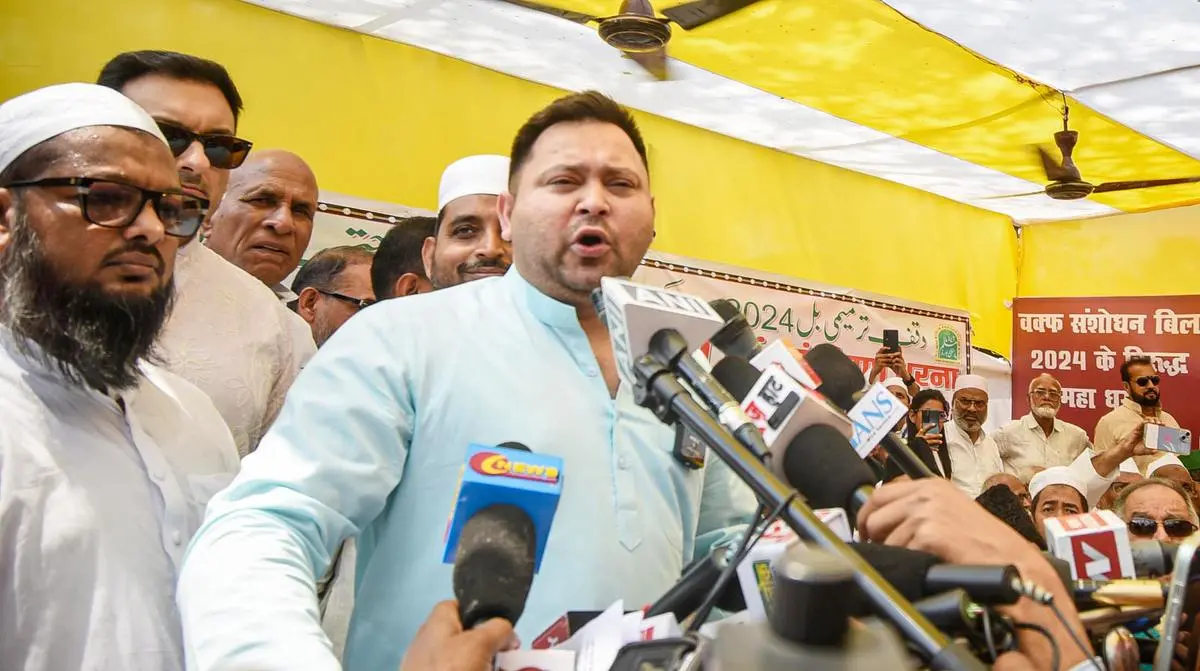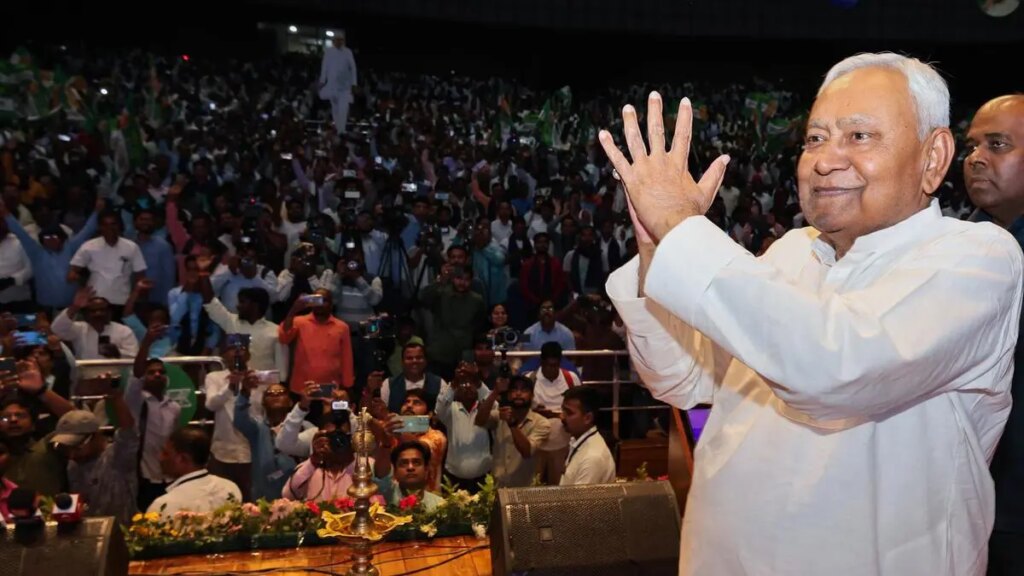With just six months to go before the Bihar Assembly election, the ruling National Democratic Alliance (NDA), led by Chief Minister Nitish Kumar, looks jaded. He faces serious questions about his health, and the NDA’s social coalition appears fractured by the Rashtriya Janata Dal’s (RJD) Muslim-Yadav-plus consolidation strategy.
The latest blow to Nitish Kumar’s Janata Dal (United), or JD(U), came when the party backed the controversial waqf amendment law. In its immediate aftermath, five Muslim leaders resigned, and the decision sparked resentment among several members of the party. The leaders who quit were Mohammad Qasim Ansari, State secretary of minority cell Mohammad Shahnawaz Malik, Bettiah (West Champaran) district vice president Nadeem Akhtar, State general secretary (minority cell) Mohammad Tabrez Siddiqui, and party member from Bhojpur Mohammad Dilshan Rayeen. JD(U) MLC Ghulam Ghaus termed the Act unconstitutional and urged President Droupadi Murmu to repeal it.
Also Read | Will Nitish Kumar remain the face of the NDA in the Bihar Assembly election?
Qasim Ansari’s resignation letter to Nitish Kumar dominated the headlines, but senior JD(U) leaders dismissed the issue, preferring to recall that when Ansari contested the 2020 election from the Dhaka Assembly seat in East Champaran district on the kite symbol (of the All India Majlis-e-Ittehadul Muslimeen), he had won only 499 votes.
While it is true that those who resigned are not top-level leaders, their decision to quit points to a growing sense of disillusionment among Muslim voters with Nitish Kumar, who, despite his alliance with the BJP, has long enjoyed their goodwill. By backing the waqf law, the JD(U) has clearly indicated that it does not want to rock the NDA boat in the State.
Muslim resentment
However, the resignations do not augur well for the JD(U) in an election year, particularly when the battle lines have become sharper, with a resurgent RJD reaching out to non-Yadav communities among the Other Backward Classes in a big way and Muslims solidly backing the Lalu Prasad-Tejashwi Yadav duo.
Only a few months ago, Ali Anwar Ansari, two-term Rajya Sabha member from the JD(U) and leader of the Pasmanda Muslim Samaj, resigned to join the Congress. The RJD-Congress combine is expected to use Ansari’s popularity to rope in Pasmanda (backward) Muslim votes.
In Bihar, power revolves around three major poles: the BJP, the RJD, and the JD(U). Smaller players such as the Congress, Chirag Paswan’s Lok Janshakti Party (Ram Vilas), or LJP(RV), Jitan Ram Manjhi’s Hindustani Awam Morcha (Secular), and Mukesh Sahani’s Vikassheel Insaan Party add weight to whichever alliance they join. So far it has been a case of two groups coming together and forming the government.
While the BJP and the RJD have never been in an alliance, the JD(U) has changed sides several times, altering the power dynamics in the State. Between 2013 and 2024, Nitish Kumar changed sides four times, earning himself the sobriquet of “Paltu Ram”, or side-switcher.
After his last return to the BJP combine in 2024, Nitish Kumar has been at pains to counter growing rumours of yet another change of sides. In March, in the presence of Home Minister Amit Shah, he declared that he had “erred twice” and promised to stay with the BJP permanently. Previously, he had given such assurances to Prime Minister Narendra Modi himself during public meetings.
Modi’s decision to do a small roadshow with Nitish Kumar in February in Bhagalpur was also aimed at scotching such speculation. For now, the BJP has stalled the possibility of Nitish Kumar making another switch to the RJD, but what is worrying for the saffron party is his declining political currency.
JD(U) powerhouse
Whether in the party or in the government, Nitish Kumar has never left anyone in doubt about where the JD(U)’s fulcrum of power lay.
In December 2023, he underscored this when he secured the resignation of party president Rajiv Ranjan Singh, alias Lalan Singh, and donned the party chief role for the second time. In April 2016, Nitish had replaced the longest-serving JD(U) president, Sharad Yadav (who served 3 terms and over 10 years), against his wishes.
Ironically, it was Nitish Kumar who made Sharad Yadav party president in 2006, replacing firebrand leader George Fernandes, who had been party president since 2003 and head of its predecessor, the Samata Party, since 1994 when it was formed.
Nitish Kumar has always managed to gain the upper hand while handling rebellion, whether from his own aide-turned-rebel Upendra Kushwaha, R.C.P. Singh in the party, or Jitan Ram Manjhi in the government.
He has also been taking the high moral ground by not promoting any family member in politics. (The nearest parallel to Nitish Kumar is Naveen Patnaik of Odisha.) There has been no charge of dynastic politics against him, until now that is. Early this year, his son Nishant Kumar emerged from the shadows and started making his political presence felt, giving rise to the speculation that Nitish Kumar was preparing to hand over the reins in view of his failing health. Videos showing him faltering and forgetting are making the rounds on social media.
Ahead of the 2019 Lok Sabha election, learning from their 2015 Assembly election defeat, the BJP wooed Nitish Kumar by offering him 16 seats despite the 2 his party had won in 2014. Nitish Kumar has been Chief Minister in governments supported by either the RJD or the BJP even when those parties have had a greater number of seats than the JD(U).
Also Read | Bihar and the new kid on the block
Now, in 2025, the BJP has again stooped to conquer, announcing Nitish Kumar as the face of the NDA in Bihar. This is a surprise, especially in light of Amit Shah’s cryptic comment in a television interview earlier, saying “we will sit together and decide”, in response to a question on who would lead the coalition in Bihar.
The RJD, too, despite repeated snubs, has not tired of stating that its doors are open for Nitish Kumar. Or, rather, Lalu Prasad says so, but Tejashwi Yadav opposes it.
Women’s support
Nitish Kumar’s strength lies in continued support from large sections of women voters across caste lines, thanks to steps such as prohibition, seat reservation for women in panchayats, and welfare measures like bicycles to school-going girls. In addition, through special programmes, he has strengthened his grip over non-Yadav Extremely Backward Classes and Mahadalits.
The JD(U)’s hold over 15 per cent of the votes helps the NDA become a winning combination, as it adds to the BJP and other allies’ 20 per cent vote share, and nullifies the RJD-Congress advantage of starting with a base of nearly 30 per cent of the votes from Muslims and Yadavs.

RJD leader Tejashwi Yadav at a dharna against the Waqf Amendment Bill, in Patna on March 26. A resurgent RJD is expected to give the NDA a stiff fight in the upcoming Assembly election.
| Photo Credit:
Pappi Sharma/ANI
However, one sees a decline in JD(U)’s vote share in Assembly elections. In the 2005 and 2010 Assembly elections, when it contested in alliance with the BJP, the party got over 20 per cent and 22 per cent of votes. In 2015, this dropped to 17 per cent when it was in alliance with the RJD; and in 2020, the JD(U) got just 15.7 per cent when in alliance with the BJP.
The declining vote share directly translated also into a fall in the number of seats: from a peak of 115 seats in 2010, the party won 71 in 2015 and just 43 seats in 2020.
In contrast, in the 2024 Lok Sabha election, it was the RJD that scored the maximum vote percentage among all parties with 22.14 per cent.
Declining clout
As early as 2013, in his book Bihar Breakthrough, Rajesh Chakrabarti said: “It would, however, be a mistake to think that the population in Bihar today extols Nitish the same way as it did going into the previous election. The gains brought by the administration have already been absorbed in the general psyche and the expectations from the government are much higher than in the Lalu era. The public is ironically less grateful than expecting… at times the discontent has boiled over to a point where Nitish’s convoy has been stoned during the Seva Yatra.”
Nitish possibly read the writing on the wall in 2015, which is why he decided to join hands with the same Lalu Prasad whose misgovernance he had made the main plank of his politics. The victory that year of the Nitish Kumar-led Mahagathbandhan, comprising the RJD and the Congress, aided by the election strategist Prashant Kishor, was as such a more complex verdict than a simple barometer of Nitish Kumar’s popularity. By 2020, the JD(U) had declined further.
Now, Prashant Kishor has formed his own party. Not surprisingly, doubts are being raised in multiple quarters about Nitish Kumar’s prospects of being projected as the chief ministerial candidate in 2025 and whether such a move will actually benefit the alliance.
Two decades is a long period in politics and there are indications of anti-incumbency having caught up with Nitish Kumar. For instance, despite the Congress being only a minor player in Bihar, its stop-migration-give-jobs yatra that started on March 16 in Champaran has gained good traction.
Champaran is the land of Mahatma Gandhi’s indigo agitation during the freedom movement. The political symbolism of the venue is strong. Prashant Kishor too had started his yatra under the banner of Jan Suraaj to connect with the masses from the same place.
Still a force to reckon with
Nitish Kumar’s supporters, on their part, cite the 2024 Lok Sabha election when JD(U) had won 12 of 16 seats it contested to buttress the point that he still counts. When doubts were being expressed about projecting Nitish Kumar as the leader of NDA in Bihar, his supporters came out in support in December last year, coining the slogan, “Jab baat Bihar ki ho, naam sirf Nitish Kumar ka ho” (When it is about Bihar, Nitish Kumar should be the only name), during their leader’s Pragati Yatra, which too started from Champaran.
Clearly, 2025 is the toughest election battle that Nitish Kumar is facing. But a confident JD(U) has come out with bold posters screaming “25 se 30, phir se Nitish’ (it is Nitish again from 2025 to 2030).
Speaking to Frontline on Nitish Kumar’s strengths and why he remains relevant, Amitabh Tiwari, political commentator and election strategist, said: “Nitish Kumar is a force multiplier; whichever party the JD(U) aligns with goes on to form the government. Bihar’s caste equations and societal conditions give him the political manoeuvrability to switch sides successfully.”
Also Read | Bihar 2025: No cakewalk for BJP, RJD or Nitish Kumar
He added: “His core base has remained more or less intact and he also brings a section of the Pasmanda Muslim votes due to his secular image. This won’t change because of Waqf.”
He also said that the BJP has been piggybacking on Nitish Kumar for the past 20 years and does not have a leader to match him or Tejashwi Yadav.
“No BJP leader has a pan-State appeal. The BJP can’t touch the magical figure on its own. Even a weakened Nitish still commands a crucial 12-15 per cent vote share. The RJD has been struggling to expand its vote base beyond Muslims and Yadavs,” he said, adding that Nitish Kumar brings acceptability and adds legitimacy to any alliance he joins.
Whether Nitish Kumar can work his magic one last time and silence the naysayers is keeping all the political pundits guessing.
Source:https://frontline.thehindu.com/politics/nitish-kumar-bihar-2025-election-analysis/article69460083.ece

